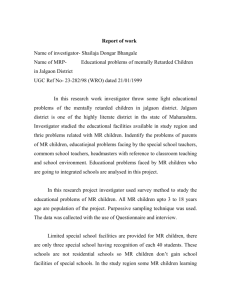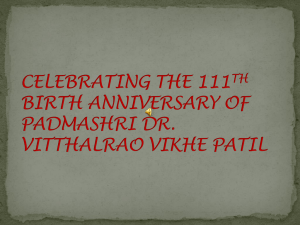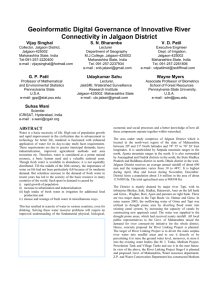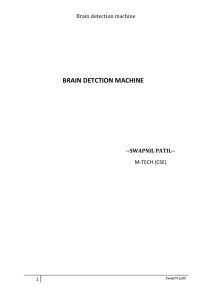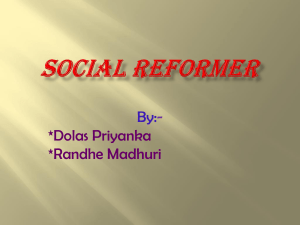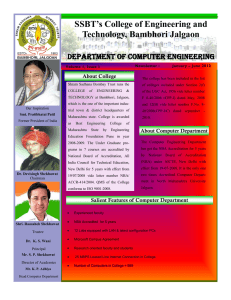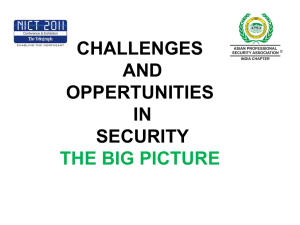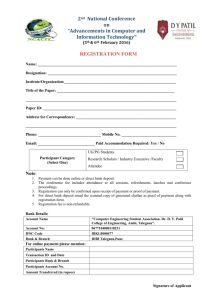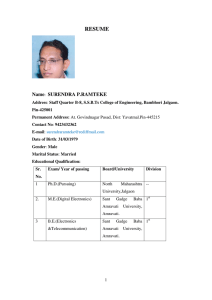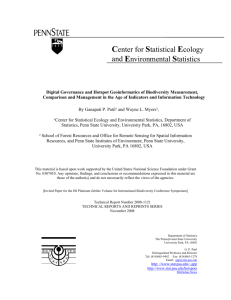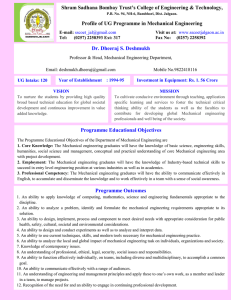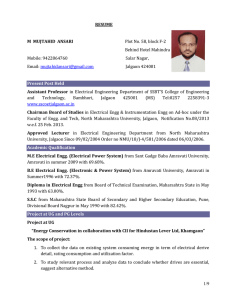Amravati University Convocation Address
advertisement
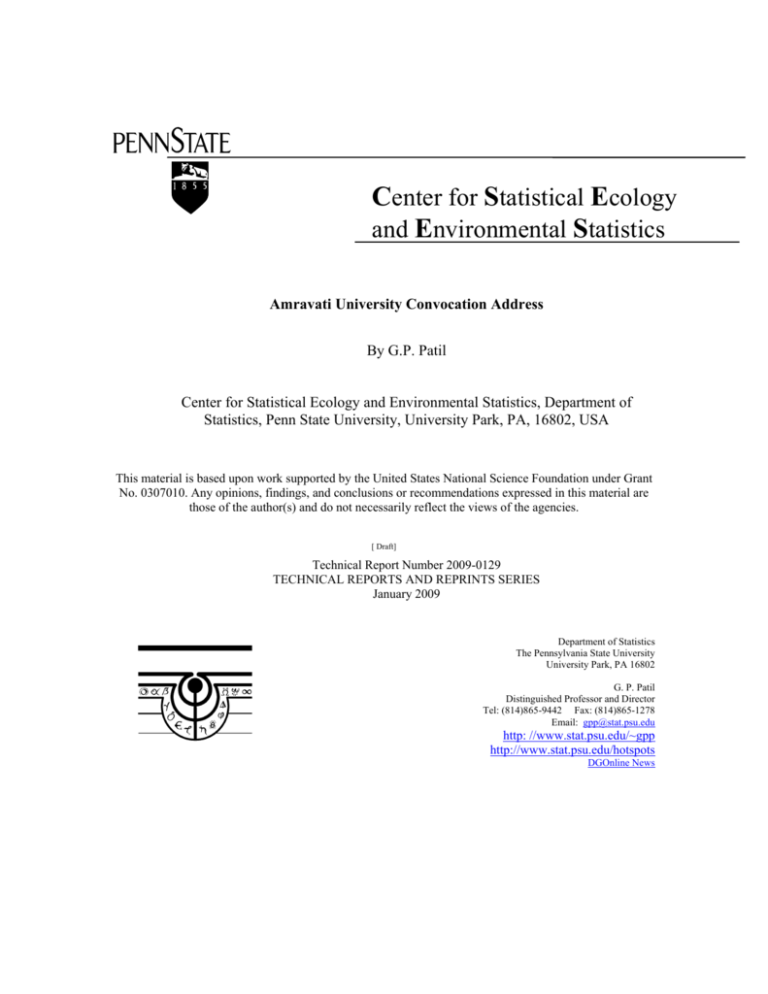
Center for Statistical Ecology and Environmental Statistics Amravati University Convocation Address By G.P. Patil Center for Statistical Ecology and Environmental Statistics, Department of Statistics, Penn State University, University Park, PA, 16802, USA This material is based upon work supported by the United States National Science Foundation under Grant No. 0307010. Any opinions, findings, and conclusions or recommendations expressed in this material are those of the author(s) and do not necessarily reflect the views of the agencies. [ Draft] Technical Report Number 2009-0129 TECHNICAL REPORTS AND REPRINTS SERIES January 2009 Department of Statistics The Pennsylvania State University University Park, PA 16802 G. P. Patil Distinguished Professor and Director Tel: (814)865-9442 Fax: (814)865-1278 Email: gpp@stat.psu.edu http: //www.stat.psu.edu/~gpp http://www.stat.psu.edu/hotspots DGOnline News Amravati University Convocation Address By G. P. Patil, Distinguished Professor and Director Center for Statistical Ecology and Environmental Statistics The Pennsylvania State University, University Park, PA USA - A Draft - Dear Everyone : Today is for us to celebrate for work well done. Today is for us to contemplate on the work to be well done. Today is for us to look back and enrich our wisdom. Today is for us to look ahead and begin the march. Exciting future indeed. Excitement of the 21st Century with its science, technology, community, and youth. I grew up in the 20th Century, starting my elementary school in a village with one room – one teacher school with one line for each class and still it was possible for me to take off. You also will. You have the additional benefit of the 21st Century Information and Communication Technology together with the Geographic Information Systems to perceptively think globally and concretely act locally, advancing local wisdom of the community and youth, using present day science, technology, management, communication, and synergism. Effective networking is a key. Sometimes it happens. Sometimes we need to help it happen. It is always nice and nurturing to be in good company. In dedicated inspirational company. I grew up with Sane Guruji, Yadunath Thatte, Raosaheb Patwardhan, Achyutrao Patwardhan, Jayaprakash Narayan with their mentoring love and affection. Baba Amte, Anna Sahasrabudhe, SM Joshi were favorite senior friends. And so also Madhukarrao Chaudhari, Bhaisaheb Y. S. Mahajan, Mohan Dharia, Vasant Bapat, Sadanand Varde, Prashantchandra Mahalanobis, C. Radhakrishna Rao, Jerzy Neyman, David Cox, E. O. Wilson, Mario Molina, and fortunately many more. I sincerely wish -1- you every luck in seeking new and nurturing friendships to enrich your personal and professional life. Feel at home everywhere. And equally important, anywhere. Wherever you choose or happen to be. And this can more easily happen if we cultivate our mindset with devotion to what we have on hand with a contemplative forward look. I am so very much excited that we are together today. I feel fully at home. And I very much hope that you also now feel at home. Let us turn today into a more and more of a historic day for all of us and together. And also for our community and youth around in the five districts of Amravati University. JalaSRI is an initiative of this nature, I would like to share with you. Extremely novel, innovative, inspiring, synergistic, productive, timely. Amravati JalaSRI is in the making in our presence with our participation in the initial footsteps of the neighborly prototype of Jalgaon JalaSRI. And what a wonderful coincidence! Both Jalgaon and Amravati mean so much to our beloved Prahbhatai, now, President of India. So, what is JalaSRI? A District Level Watershed Surveillance and Research Institute – A Triad of Academia, Agencies, and Community for Innovative Rainwater Harvesting and Management in the face of water scarcity. And how do we quickly take to it within our five districts of Amravati University. Soon after the great JalaSRI on the Stage Dance Drama by talented Jhelum Paranjape and her well known Troupe at Smitalay, Mumbai. You are all invited and with your interested friends and collegues. Let us give a good hand to our Vice Chancellor Kamal Singh for her vision to start Amravati JalaSRI. And to Professor Khadri to be its coordinator. And also to Devisingh Shekhavat for his interest and support. So what is JalaSRI? It may be best to see it by example of our next door prototype of Jalgaon JalaSRI within the broader context of the international initiative of Digital Governance and Hotspot Geoinformatics for Monitoring, Etiology, Early Warning and Sustainable Management. -2- -3- -4- -5- -6- -7- -8- -9- - 10 - - 11 - - 12 - - 13 - - 14 - - 15 - - 16 - - 17 - - 18 - - 19 - - 20 - - 21 - - 22 - - 23 - - 24 - - 25 - - 26 - - 27 - - 28 - - 29 - - 30 - Amravati JalaSRI is fortunate to have the benefit of synergism and collaboration of Jalgaon JalaSRI on the starting up of the exciting innovative geoinformatic work involving the fifty thousand hectare region of Bodwad Irrigation Project extending over areas of districts of Jalgaon, Akola, Yavatmal, Buldhana covering parts of watersheds of Purna River, Tapi River, and their tributaries in the region, budgeted at fifteen hundred crores over the next five year period. Also exciting is the news that the national elevanth five year plan recognizes resource convergence mantra model at the district level and have budgeted twelve hundred crores per district for priority activities of sustainable development and livelihood recommending use of maps and information and communication technology tools. How - 31 - nice that JalaSRI has been at it already for four years, even implementing the tools of cross disciplinarity of digital governance and hotspot geoinformatics that integrates geospatial maps and information technology. We live in the age of indicators in the age of geospatial information and technology. For this, we need to have and further build disciplinarian strengths leading to cross disciplinary, transdisciplinary strengths. And this mindset we need in each JalaSRI, in each one of us, at work and at home! I have been fortunate in this regard, and wish you also great success and satisfaction. Personally, I have a Ph.D. in Mathematics, a D. Sc. in Statistics, an Hon. Sc. D. in Biological Sciences, and an Hon. D. Litt. in Letters. Family-wise, I have a very interesting cross disciplinary family with my wife Lalita a PhD in Biology and MBA in Management, first son Parimal on the Harvard University faculty for Philosophy and Comparative Religions, second son Parag on the University of Michigan faculty for Neurosurgery and Biomedical Engineering, third son Pawan the Chief Executive of Global Fund for Youth Investment at the World Bank, and the daughter Priya with the International Council for Research on Women, herself an expert on emerging infectious disease evaluation and management. Parimal’s wife Emily also teaches at Harvard, in History and Literature, with her specialization on Mahabharat. Pawan’s wife Lisa is a writer, even with her law and management expertise and experience, while being a multinational and international champion in karate. With four grandchildren, Bodhi, Anand, Anjali, and Meijin, the GrandParent GP usually looks matching 4 : 74 modulo 70, and at times 24 : After 50, discount 50! Have a great day. Have a great future. With JalaSRI around. Jalgaon JalaSRI Website : www.jalasri.kces.in Penn State NSF DGP Website : www.stat.psu.edu/hotspots - 32 - References Bendale, Devyani, Zambre, Rajan, Kardile, Shirish, Patil, Ganapati. (2008). Smart Sensors Based Water Filtration Systems for Rural Areas in Jalgaon District, Maharashtra State, India, Technical Report Number 2008–1010, Jalgaon JalaSRI Bhalsing, Sanjivani, Zambre, Rajan, Patil, Ganapati. (2008). Biosensor for Drinking Water, Technical Report Number 2008-1020, Jalgaon JalaSRI Myers, W., Bishop, J., Brooks, R., O’Connell T., Argent D., Storm G., Stauffer J., and R. Carline. (2000). Pennsylvania Gap Analysis Project; leading landscapes for collaborative conservation: Final report. School of Forest Resources, Cooperative Fish and Wildlife Research Unit, and Environmental Resources Research Institute. Pennsylvania State University, University Park, PA. Patil, G.P., Pawde, S.P., Rane, G.M., Zambre, R.A., Wani, S.P., Paranjape, Jhelum. (2008). A Picturesque Informative Pamphlet : District Level Watershed Surveillance and Research Institute JalaSRI – A Novel and Innovative Prototype Initiative for Digital Governance, Hotspot Geoinformatics, Present Day Science and Technology with Local Wisdom, Youth Investment and Community Development to Help Build a Sustainable Digital Government Research Community for District Level Natural Resources Development and Sustainable Management, Technical Report Number 2008-1204, Pennsylvania State University Center for Statistical Ecology and Environmental Statistics, University Park, PA Patil, G.P. (2007). Statistical geoinformatics of geographic hotspot detection and multicriteria prioritization for monitoring, etiology, early warning and sustainable management for digital governance in agriculture, environment, and ecohealth, Journal of Indian Society of Agricultural Statistics, 61, 132–146. Patil, G.P., Taillie, C. (2003). Geographic and network surveillance via scan statistics for critical area detection, Statistical Science, 18(4), 457–465. Patil, G.P., Taillie, C. (2004). Upper level set scan statistic for detecting arbitrarily shaped hotspots. Environmental Ecological Statistics, 11, 183–197. Patil, G.P., Acharya, R., Glasmier, A., Myers, W., Phoha, S., and Rathbun, S. (2006). Hotspot detection and prioritization geoinformatics for digital governance, In Digital Government: Advanced Research and Case Studies, (Eds., H. Chen, L. Brandt, V. Gregg, R. Traunmüller, S. Dawes, E. Hovy, A. Macintosh, C. Larson), Springer Publishers, US. - 33 - Patil, G.P., Acharya, R., Myers, W., Phoha, S., and Zambre R. (2007). Hotspot Geoinformatics for detection, prioritization, and security, In Encyclopedia of Geographical Information Science, (Eds., S. Shekhar and H. Xiong), Springer Publishers. Patil, G.P., Joshi, S.W., and Rathbun, S.L. (2007). Hotspot geoinformatics, environmenntal risk, and digital governance, In Encyclopedia of Quantitative Risk Analysis, Wiley, New York.–927, Idea Group Reference, Hershey, PA. Patil, G.P., Patil, V.D., Pawde, S.P., Phoha, S., Singhal, V., and Zambre, R. (2008). Digital governance, hotspot geoinformatics, and sensor networks for monitoring, etiology, early warning, and sustainable management, In Geoinformatics for Natural Resource Management, Ed. P.K. Joshi, Nova Science Publishers, New York (in press). Rane, Gauri, Pandey, Rahul, K., Bhardwaj, Jaya, Murthy, Rama, Myers, Wayne, Patil, Ganapati. (2008). Biogeographical and Bio-cultural Context for Collaborative Conservation and Resource Sustainability in Jalgaon District of Maharashtra, India, Technical Report Number 2008-1015, Jalgaon, JalaSRI Sardar, Bidhan, Behera, Pranita, Mahendran, Vikrant, Zambre, Rajan, Myers, Wayne, Patil, Ganapati. (2008). Identification and Prioritization of Critical Subwatersheds for Soil Conservation Management using SWAT Model – A case study of Jalgaon district, Maharashtra, Western India, Technical Report Number 2008-1005, Jalgaon JalaSRI - 34 -
